 |
 |
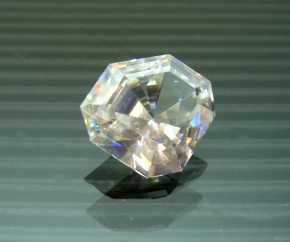 |
| 白鉛鉱双晶(Cerussite Twin
Crystal) 50x46mm |
白鉛鉱ルース(Faceted
cerussite) 13.83ct 13.5x12.00mm | |
| Tsumeb Mine, Namibia | Kombat Mine, Tsumeb, Namibia | |
白鉛鉱(Cerussite)
 |
 |
 |
| 白鉛鉱双晶(Cerussite Twin
Crystal) 50x46mm |
白鉛鉱ルース(Faceted
cerussite) 13.83ct 13.5x12.00mm | |
| Tsumeb Mine, Namibia | Kombat Mine, Tsumeb, Namibia | |
化学組成
(Formula)
結晶系
(Crystal System)
結晶形
(Crystal Form)
モース硬度
(Hardness)
比重
(Density)
屈折率
(Refractive Index)
複屈折
(Birefringence)
PbCO3
直方晶系
(Orthorhombic)


3 - 3½
6.53-57
1.803 - 2.076
0.273
名前と産状(Name and Occurence)
鉱物名としては珍しい例ですがラテン語の " cerussa : 鉛白、おしろい" を語源とする命名です。
従ってこの言葉は現代の英語やラテン系の言葉にそのまま残って使われています。
その名のとおり、白鉛鉱を粉砕して顔料や白粉として使用していました。
しかし白鉛鉱の白粉は鉛中毒の原因となったため、日本では1934年に使用が禁止されました。
白鉛鉱は二次成因の鉱物とされています。がしばしば双晶や三連晶、樹枝状の大きく美しい結晶として発見されます。
従ってトルコ石のような単純な二次成因ではなく、方鉛鉱や硫酸鉛鉱等の鉱脈に炭酸塩を含む熱水の貫入による置換作用の様な、限りなく一時成因に近い環境下で生成した鉱物と考えるべきでしょう。
広範に発見され、量が多い場合は主要な鉛の鉱石となります。
とりわけナミビアのツメブ鉱山や隣接するコンバット鉱山からは透明な宝石質の結晶が、またオーストラリアのブロークン・ヒル鉱山からは針状や双晶が連なったスノー・フレークと呼ばれる見事な結晶が採れました。
The name cerussite derives from Latin word "cerussa : white lead pigment(ceruse)". Cerussite is a secondary mineral, occuring in the oxidation zone of lead veins, associated with galena and anglesite , and is formed by the action of carbonated solution on these minerals.
The best specimens come from Tsumeb, Namibia, where trillings up to 200mm in diameter occured. Large twins also known from Broken Hill, Australia.
世界の白鉛鉱(World's cerussite crystals)
 |
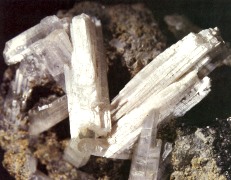 |
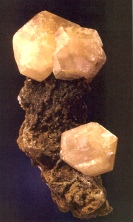 |
| 25x22cm Proprietary Block 14
mine Broken Hill , Australia Noel Frank Collection |
2cm Príbram, Czech Republic |
7cm the Gardner mine, Bisbee Arizona, U.S.A. Richard W. Graem Collection |
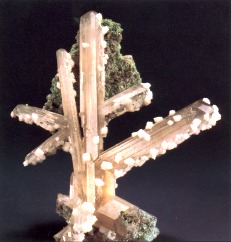 |
 |
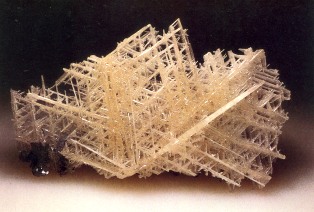 |
 |
| 白い苦灰石結晶を伴う白鉛鉱 Cerussite with white dolomite rhombos 9cm Houston Museum of Natural Science |
自然銅上の白鉛鉱双晶 Twinned mass of cerussite on native copper |
14cm
wide Miriam and Julius Zweibel Collection |
白鉛鉱の宝石質双晶 6.5cm Gemmy cerussite twin Houston Museum of Natural Science |
| Tsumeb Mine, Namibia | Kombat Mine, Namibia | ||
宝石質の白鉛鉱(Gemmy cerussite)
冒頭の白鉛鉱結晶は20年ほど昔に、パリ郊外の小さな町の鉱物フェアにてツメブ鉱山産のマンガン方解石のラベル付で見かけました。魅力的な標本ではありませんが、色合いとずっしりとした重さから方解石とは考えられず、不明なものは調べるのみという好奇心から買い求めました。
6.55の比重から直ちに白鉛鉱と分かりました。その宝石質の結晶があるとは、同じく冒頭のルースを入手した最近になって初めて知りました。
このルースは南アフリカ産としか分からず、それ以上の正確な産地は不明です。
しかし素晴らしく透明な宝石質の白鉛鉱結晶産地は上の写真の標本のように、ナミビアのツメブ鉱山に近いコンバット鉱山と考えられます。
0.273と天然の鉱物では最も高い複屈折率による光の分散で圧倒的な量のファイアーが撒き散らされる様は見事です。
残念ながら低いモース硬度と完全な劈開性のため、宝飾品には不向きです。
仮に使ったとしても、時代遅れの安物の合成ルチルと間違えられかねませんから、これはただ眺めるだけの典型的なコレクターの宝石と言えましょう。
Cerussite crystal on the top was labeled as "Mangano calcite" from Tsumeb Mine at the small mineral fair in a suburb town of Paris for about 20 years ago. Although it was not spectacular specimen, I was tempted to get it, in order to identify the true charactor, because it did not looke like calcite, due to color, luster and extreme heaviness. The measured density of 6.55 immediately revealed that this mineral was cerussite. I did not realize there exist gemme cerussite til I obtained the facetecd 13.83ct stone of the top photo, recently. As in case of faceted stone, in general, exact locality was unknown other than South Africa. I estimate this faceted stone is of Kombat Mine, near Tsumeb mine, Namibia, for such superb transparency. Because of the highest birefringence of 0.273 as natural mineral, cerussite shows spectacular dispersion, which can not be used regrettably for jewelery, due to low hardness and perfect cleavage. Another regret is, that this rare stone with overwhelming fire is easily misunderstood with old fashioned synthetic rutile, once employed as cheap diamond imitation. Faceted cerussite is a typical collector's gemstone, just to appreciate its glittering fire.
| Top | Gemhall |